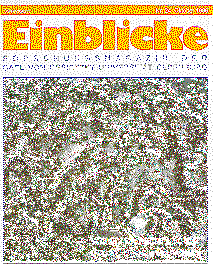Presse & Kommunikation
| EINBLICKE NR.24 | OKTOBER 1996 |
|
FORSCHUNGSMAGAZIN DER CARL VON OSSIETZKY UNIVERSITÄT OLDENBURG
|
|

Inhalt
- Von Schwarzen Flecken und Schwarzen Flächen
- Konflikte zwischen Ökologie und Urbanität
- Fernerkundung - nah gesehen
- Im Visier der Stasi: Katholische Studentengemeinden
- "Auf den Großmärkten ... bildet das Oldenburger Schwein eine Klasse für sich"
- Nachrichten der Universitätsgesellschaft
- Notizen aus der Universität
- Summaries
Summary
Of Black Spots and Black Areas
In early summer, 1996, so-called "black spots" were reported on the tidal flats in the East Frisian Wadden Sea. They subsequently grew into very large anoxic areas. While some regard this as a signal for a dying Wadden Sea, caused by environmental pollution, others call it a weather-induced short-term phenomenon. Black spots have been examined in situ and in experimental simulation by the Ecosystem Research Project Wadden Sea for at least seven years. It has been shown that high nutrient supplies over decades have led to a concentration of organic matter in local areas. In these areas the microbial decomposition of the organic matter can consume all available oxygen. Under these conditions, black spots can enlarge to huge "black areas" as a result of coinciding untypical environmental stress factors.Authors: Thomas Höpner, Gerd Meurs
Conflicts between Ecology and Urbaneness
The ecological restructuring of the cities and of society is more than the introduction of a different technology: It includes the necessity of a different way of life. In this article, the example of ecologically-oriented housing is used to show that environmentally-based behaviourial expectations can conflict with widely-held political values, with promises of urban emancipation and with the dominant model of home life. Based on a recently completed research project funded by the Volkswagen Foundation.Authors: Norbert Gestring, Hans-Norbert Mayer, Walter Siebel
A Close Look at Remote Sensing
The exploration of the Planet Earth has entered a new phase: Over the centuries of personal - often quite risky - effort, and almost 200 years of observation from the air, mankind has been developing techniques and instruments for exploring the physical environment, a change from the naked eye to sophisticated optoelectronic systems on platforms orbiting in space. These remote sensors make use of the near, middle, and thermal infrared bands, as well as the visible portion of the electromagnetic spectrum. Each band features a specific range of attributes which can be applied to land use/land cover mapping. The origin and properties of remotely sensed data are discussed here, the research process of generating a thematic map is briefly demonstrated, and possible further applications are pointed out.
Author: Dietrich Hagen
![]()
Targeted by the Stasi: Catholic Student Groups
Because they had many contacts with individuals and institutions in the West, the student church groups in the DDR (East Germany) were a favourite object of observation for the Stasi (East German Secret Police). Their main aim, more than simply to discover what potential for criticism existed in the groups, was to achieve direct influence. The secret police efforts were, in part, successful, as is shown in this article. It was written in conjunction with the research project "Catholic Student Groups (KSG) in the DDR", which was supported by the German Research Society.Author: Friedrich W. Busch, Peter-Paul Straube
![]()
"At the Livestock Markets ... Oldenburg Swine are in a Class of their Own"
Between 1871 and 1914, agriculture in the Duchy of Oldenburg went through profound changes. The northern parts of the Duchy had already been producing for an export market, and experienced both growth and change in the direction of export. But the middle and southern part of the Duchy, which until then was an underdeveloped subsistence economy, turned into a highly efficient export-oriented one based on livestock production and finishing with imported feed.Authors: Bernd Mütter, Robert Mayer